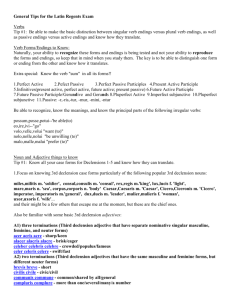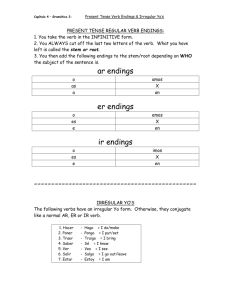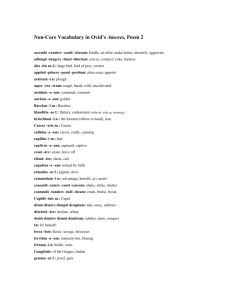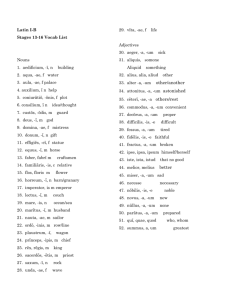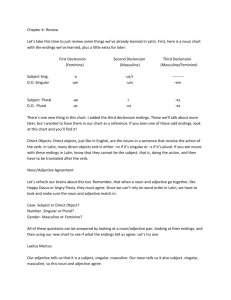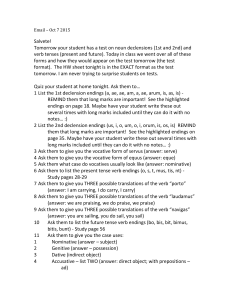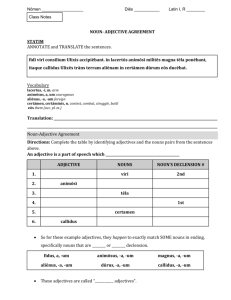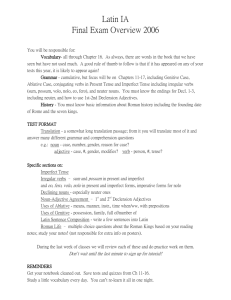Grammatical Summaries for Introductory Latin Accent long
advertisement
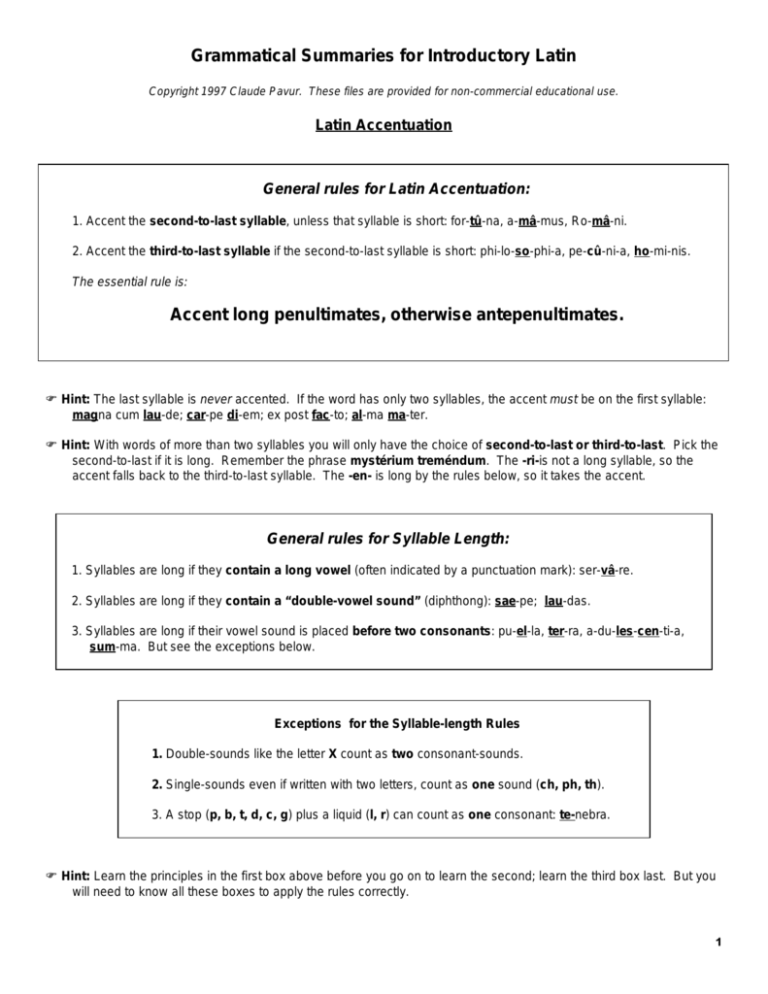
Grammatical Summaries for Introductory Latin Copyright 1997 Claude Pavur. These files are provided for non-commercial educational use. Latin Accentuation General rules for Latin Accentuation: 1. Accent the second-to-last syllable, unless that syllable is short: for-tû-na, a-mâ-mus, Ro-mâ-ni. 2. Accent the third-to-last syllable if the second-to-last syllable is short: phi-lo-so-phi-a, pe-cû-ni-a, ho-mi-nis. The essential rule is: Accent long penultimates, otherwise antepenultimates. F Hint: The last syllable is never accented. If the word has only two syllables, the accent must be on the first syllable: magna cum lau-de; car-pe di-em; ex post fac-to; al-ma ma-ter. F Hint: With words of more than two syllables you will only have the choice of second-to-last or third-to-last. Pick the second-to-last if it is long. Remember the phrase mystérium treméndum. The -ri-is not a long syllable, so the accent falls back to the third-to-last syllable. The -en- is long by the rules below, so it takes the accent. General rules for Syllable Length: 1. Syllables are long if they contain a long vowel (often indicated by a punctuation mark): ser-vâ-re. 2. Syllables are long if they contain a “double-vowel sound” (diphthong): sae-pe; lau-das. 3. Syllables are long if their vowel sound is placed before two consonants: pu-el-la, ter-ra, a-du-les-cen-ti-a, sum-ma. But see the exceptions below. Exceptions for the Syllable-length Rules 1. Double-sounds like the letter X count as two consonant-sounds. 2. Single-sounds even if written with two letters, count as one sound (ch, ph, th). 3. A stop (p, b, t, d, c, g) plus a liquid (l, r) can count as one consonant: te-nebra. F Hint: Learn the principles in the first box above before you go on to learn the second; learn the third box last. But you will need to know all these boxes to apply the rules correctly. 1 First Declension Endings Case Name Nominative 1st Decl. Endings Sing. Plural -A -AE Nom. or N. Genitive -AE -ÂRUM Gen. or G. Basic Meaning of the case Example the “subject” case: indicates what performs the action of the verb. porta the “possession” case: indicates ownership, as apostrophe + s does in English. portae porta est magna. The gate is large. magnitudo portae = the gate’s size, the size of the gate magnitudo portârum = the gates’ size Dative -AE -ÎS Dat. or D. the “indirect object” case: indicates what receives the action of the verb indirectly. portae make a bolt portae (for the gate) make bolts portis (for the gates) Accusative -AM -ÂS Acc. Ablative -Â Abl. -ÎS the “direct object” case: indicates what receives the action of the verb directly. Used with some prepositions. the “by-with-from” case: shows some kind of special relationship to something else in the sentence. Used with some prepositions. portam, portâs specta portam! Look at the gate! specta portas! Look at the gates! portâ, portîs de portâ = down from the gate de portîs = down from the gates General rule for forming Declension 1: 1. The root form given will be the nominative and genitive endings (-a, -ae) : porta, -ae; fama, -ae; fortuna, -ae. 2. Add the above endings to the root: the genitive minus the -ae: port- There are adjectives that follow the same pattern of endings: antîqua, tua, mea, magna, multa. The endings of adjectives must agree with the gender and the number of the nouns they modify. magna porta tuas filias meam patriam amo. F CLUE: Most of these words are feminine. Exceptions like agricola (farmer) and nauta (sailor) take the regular 1st declension endings, but the adjectives that modify them must be masculine in form. N.B.!: Some of the endings are the same for different cases; you must know the context to tell which case is being used. -ae = gen. sg., dat. sg., nom. pl. -îs = dat. pl., abl. pl. N.B.!: You must remember to which declensions nouns belong. Knowing the nominative and genitive forms is most helpful. 2 Second Declension Masculine Endings Case Name Nominative Nom. or N. 2st Decl. Masc. Endings Sing. Plural -US / -ER -Î Meanings subject Examples > amîcus, amîcî puer, puerî ager, agrî puer amicus est. = the boy is a friend. puerî amicî sunt. ager magnus est. = The field is large. agrî magnî sunt. = The fields are large. Genitive -Î -ÔRUM Gen. or G. possession > amîcî, amicôrum puerî, puerôrum agrî, agrôrum amîcus puerôrum = the friend of the boys agrî magnitudo = the field’s size Dative -Ô -ÎS Dat. or D. indirect object > amicô, amicîs puerô, puerîs agrô, agrîs pater agrum puerô dat. = The father is giving the field to (his) boy. amîcô aquam puer dat. = The boy is giving water to his friend. Accusative -UM -ÔS Acc. direct object > amîcum, amîcôs puerum, puerôs agrum, agrôs multôs amîcôs desiderat. = He /she wants many friends. puellae agrum vident. = The girls see the field. Ablative -Ô -ÎS Abl. “by-withfrom” > amicô, amicîs puerô, puerîs agrô, agrîs in agrô stat puer. = The boy is standing in the field. cum amîcô agrum servat puella. = The girl is saving the field with her friend. General rule for forming Declension 2: 1. The root forms given will be the nominative and genitive endings (-us, -î; sometimes: -er, -î) amîcus, -î; puer, puerî; ager, agrî 2. Add the above endings to the root: the genitive minus the -î: amîc- , puer- , agr-- There are adjectives that follow the same pattern of endings: antîquus, tuus, meus, magnus, multus. The endings of adjectives must agree with the gender and the number of the nouns they modify. magnus ager tuôs amîcôs F CLUE: multôs puerôs video. Almost all of these words are MASCULINE in gender. N.B.!: Some of the endings are the same for different cases; you must know the context to tell the case. -î = gen. sg., nom. pl. -ô = dat. sg., abl. sg -îs = dat. pl., abl. pl. 3 Second Declension Neuter Endings Case Name Nominative 2st Decl. Neuter. Endings Sing. Plural -UM -A Meanings Examples subject > donum, dona templum, templa templum magnum est. = The temple is big. Nom. or N. dona magna sunt. = The gifts are great. Genitive -Î -ÔRUM Gen. or G. Dative -Ô -ÎS Dat. or D. Accusative -UM -A Acc. possession > donî, donôrum templî, templôrum portâs templî video. = I see the gates of the temple. indirect object > donô, donîs templô, templîs magna dona templîs sunt. = The big gifts are for the temple. direct object > donum, dona templum, templa multa dona dant. = They give many gifts. puellae agrum vident. = The girls see the field. Ablative -Ô Abl. -ÎS “by-withfrom” > donô, donîs templô, templîs ex templô currit vacca. = A cow is running out of the temple. General rule for forming Declension 2, neuter nouns: 1. The root forms given will be the nominative and genitive endings (-um, -î ). templum, -î donum, -î consilium, -iî officium, -iî 2. Add the above endings to the root (the genitive minus the -î) templ- , don- , consili-, offici- . There are adjectives that follow the same pattern of endings: antîquum, tuum, meum, magnum, multum. The endings of adjectives must agree with the gender and the number of the nouns they modify. magnum templum multa dona consiliîs bonîs F CLUE: Neuter nominatives and accusatives are always the same form: nom. sg.: templum acc. pl.: templum nom. pl.: templa acc. pl.: templa N.B.!: Some of the endings are the same for different cases; you must know the context to tell the case. -um = nom. sg., acc. sg. -ô = dat. sg., abl. sg -a = nom. pl., acc. pl. -îs = dat. pl., abl. pl. 4 Third Declension Endings Case N. 3d Decl. Masc. / Fem. Endings Sing. Plural ----- -ES Examples of MASCULINE and FEMININE 3d declension nouns > rex, reges virtus, virtutes rex bonus multas virtutes praebet. = The good king shows many virtues. virtutes civitatem servant. = Virtues save the state. G. -IS -UM > regis, regum virtutis, virtutum regis patria antiqua est. = The king’s fatheland is ancient. praemia virtutum omnes desiderant. = All want the rewards of the virtues. D. -I -IBUS > regi, regibus virtuti, virtutibus magna dona regi dabant. = They used to give great gifts to the king. virtutibus student. = They are eager for the virtues. Acc. -EM -ES > regem, reges virtutem, virtutes regem vident feminae. = The women see the king. puellae virtutes multas habent. = The girls have many virtues. Abl. -E -IBUS > rege, regibus virtute, virtutibus virtute potest inimicos superare. = By means of virtue, she can overcome her enemies. de regibus cogitant nautae. = The sailors are thinking about the kings. Case N. 3d Decl. Neuter Endings Sing. Plural ----- -A Examples of NEUTER 3d declension nouns > corpus, corpora tempus, tempora tempus fugit. = Time is fleeing. Tempora bona sunt. = The times are good. G. -IS -UM > corporis, corporum temporis, temporum corporis magnitudo = the size of the body D. -I -IBUS > corpori, corporibus tempori, temporibus corporibus nostris = for our bodies Acc. ----- -A > corpus, corpora tempus, tempora corpora in agris videbant feminae. = The women saw the bodiesin the fields. Abl. -E -IBUS > corpore, corporibus tempore, temporibus ex tempore dicebat. = He spoke “out of that moment” (ex tempore). Notice: (1) Neuter nominatives and accusatives are the same, as usual. (2) The stem is the genitive singular minus the -is: reg, virtut- tempor- . You must know it to form the cases. 5 Present Imperatives for Conjugations I and II Ø I laudare = to love lauda! = (you) love! laudate! = (you pl.) love! Ø II moneo = to advise mone! = (you) warn! monete! = (you pl.) advise! III currere = to run curre! = (you) run currite! = (you pl.) run! III-io capere = to take cape! = (you) take! capite! = (you pl.) take! IV audire = to hear audi! = (you) hear! audite! = (you pl.) hear! General rule for forming Conjugation I and II present imperatives, singular and plural: 1. Take the “present stem” (the part to which the endings are added, e.g., lauda-, da-, ama-, mone-, vide-). 2. By itself, it is the present singular imperative: lauda! da! ama! mone! vide! 3. Add “ -te” and you have the present plural imperative: laudate! date! amate! monete! videte! First two parts of the verb laudo moneo do erro servo conservo valeo video voco amo cogito debeo Pres.imp.sg. laudare monere dare errare servare conservare valere videre vocare amare cogitare debere lauda mone da erra serva conserva vale vide voca ama cogita debe Pres.imp.pl. laudate monete date errate servate conservate valete videte vocate amate cogitate debete First Conjugation words like amo, erro, cogito, do, laudo, servo, etc., have stems that end in -a. Second Conjugation words like video, valeo, timeo, debeo, moneo, etc., have stems that end in -e. You can identify the conjugation of a verb by learning the present infinitive and removing the final -re: if the last vowel is a long a, the verb is probably first conjugatjion (amare – re = ama), if it is long e, it is probably second conjugation (monere – re = mone). F CLUE: Second Conjugation words tend to have -EO in the 1st sg present indicative active form: moneo, video, debeo, valeo, timeo. N.B.!: You must remember to which conjugations the verbs belong. This will be a great and necessary help for many forms. The more reading and exercise you do, the less of a problem this will be. 6 Declensions 1, 2, and 3 Endings 1st Decl. Feminine 2nd Decl. Masc. 2nd Decl. Neuter. 3d Decl. Masc. / Fem. 3d Decl. Neuter Sing. Plural Sing. Plural Sing. Plural Sing. Plural Sing. Plural -A -AE -US / ER -Î -UM -A ----- -ES ----- -A -AE -ÂRUM -Î -ÔRUM -Î -ÔRUM -IS -UM -IS -UM -AE -ÎS -Ô -ÎS -Ô -ÎS -I -IBUS -I -IBUS -AM -ÂS -UM -ÔS -UM -A -EM -ES ----- -A -Â -ÎS -Ô -ÎS -Ô -ÎS -E -IBUS -E -IBUS Sing. Plural Sing. Plural Sing. Plural Sing. Plural Sing. Plural puella puellae puer pueri templum templa homo homines corpus corpora puellae puellarum pueri puerorum templi templorum hominis hominum corporis corporum puellae puellîs puero puerîs templô templîs homini hominibus corpori corporibus puellam puellas puerum pueros templum templa hominem homines corpus corpora puellâ puellîs puero puerîs templo templîs homine hominibus corpore corporibus Notice the similariites and differences across the table for each case, especially the accusative: Singulars nominative puella puer templum homo corpus genitive puellae pueri templi hominis corporis dative puellae puero templô homini corpori accusative puellam puerum templum hominem corpus ablative puellâ puero templo homine corpore Plurals nominative puellae pueri templa homines corpora genitive puellarum puerorum templorum hominum corporum dative puellîs puerîs templîs hominibus corporibus accusative puellas pueros templa homines corpora ablative puellîs puerîs templîs hominibus corporibus 7 All Declension Endings Compared SINGULAR I II III IV V *** m n m/f n m/f n *** -a -us* -um (various) (various) -us -û -ês -ae -î -î -is -is ûs -ûs -êî -ae -ô -ô -î -î -ui -û -êî -am -um -um -em (= nom.) -um -û -em -â -ô -ô -e / -î** -e / -î** û -û -ê * sometime -er, as in puer, ager and V are almost all feminine. ** -î for adjectives of the third declension and special neuter nouns like mare *** The nouns of I PLURAL I II III IV V *** m n m/f n m/f n *** -ae -î -a -es -a / -ia -ûs -ua -ês -ârum -ôrum -ôrum -um / -ium -um / -ium -uum -uum -êrum -îs -îs -îs -ibus -ibus -ibus -ibus -êbus -âs -ôs -a -ês -a / -ia -ûs -ua -ês -îs -îs -îs -ibus -ibus -ibus -ibus -êbus Remember: (1) Neuter nominative and accusative forms are identical. (2) Neuter plural nominatives and accusatives usually end in -a. 8 Hic / Ille / Iste and Adjectives with -IUS Genitives The pronouns hic, ille, iste also have -îus and -î in the genitive and dative singulars (but huic for the dative singular for hic, haec, hoc). Practice saying aloud the following tables until you become very familiar with the sounds of these forms. Notice especially the forms that are underlined. The plurals are regular, just like the plurals for bonus, bona, bonum except for haec as neuter plural nominative / accusative. hic haec hoc ille illa illud iste ista istud huius huius huius illîus illîus illîus istîus istîus istîus huic huic huic illî illî illî istî istî istî hunc hanc hoc illum illam illud istum istam istud hôc hâc hôc illô illâ illô istô istâ istô hî hae haec illî illae illa istî istae ista hôrum hârum hôrum illôrum illârum illôrum istôrum istârum istôrum hîs hîs hîs illîs illîs illîs istîs istîs istîs hôs hâs haec illôs illâs illa istôs istâs ista hîs hîs hîs illîs illîs illîs istîs istîs istîs hic, haec, hoc = this hic vir = this man, haec puella = this girl, hoc studium = this eagerness N.B: haec can also be neuter plural nom/acc: haec vitia, haec basia ille, illa, illud = that ille liber = that book, illa civitas = that state, illud tempus = that time iste, ista, istud = “that (x) of yours” ista sententia = “that opinion of yours (which I do not share)” “-ius adjectives” Everything is regular about the following important adjectives, except singular genitives (-ius) and singular dative (-î) forms. Remember these words through the mnemonic “unus nauta”: N.B.: Alius, a, um usually becomes alterîus in the genitive, but alîus is also possible. Unus, una, unum one Neuter, neutra, neutrum neither Nullus, nulla, nullum none Alius, alia, aliud other, another Ullus, ulla, ullum any Uter, utra, utrum either, which (of two) Solus, sola, solum alone, only Totus, tota, totum whole, entire Alter, altera, alterum the other (of two) 9 Examples for First Person Endings in the Indicative Mood, All Conjugations Simple Tenses I II III III-IO IV present active AMO MONEO MITTO CAPIO AUDIO present passive AMOR MONEOR MITTOR CAPIOR AUDIOR imperfect active AMABAM MONEBAM MITTEBAM CAPIEBAM AUDIEBAM imperfect passive AMABAR MONEBAR MITTEBAR CAPIEBAR AUDIEBAR AMABO MONEBO MITTAM CAPIAM AUDIAM AMABOR MONEBOR MITTAR CAPIAR AUDIAR future active future passive Perfect Tenses I II III III-IO IV present perfect active AMAVI MONUI MISI CEPI AUDIVI present perfect passive AMATUS/-A SUM MONITUS/-A SUM MISSUS/-A SUM CAPTUS/-A SUM AUDITUS/-A SUM past perfect active AMAVERAM MONUERAM MISERAM CEPERAM AUDIVERAM past perfect passive AMATUS/-A ERAM MONITUS/-A ERAM MISSUS/-A ERAM CAPTUS/-A ERAM AUDITUS/-A ERAM future perfect active AMAVERO MONUERO MISERO CEPERO AUDIVERO future perfect passive AMATUS/-A ERO MONITUS/-A ERO MISSUS/-A ERO CAPTUS/-A ERO AUDITUS/-A ERO 10 Active and Passive Endings for the First Conjugation in the Indicative Mood Simple Tenses Tense-Voice Principal Part Used Sign Ending EXAMPLE Possible translations PRESENT ACTIVE present stem, taken from the second principal part (depends on conjugation) -o AMO I love, I do love, I am loving PRESENT PASSIVE present stem, taken from the second principal part (depends on conjugation) -r AMOR I am loved, I am being loved IMPERFECT ACTIVE present stem, taken from the second principal part -ba- -m AMABAM I was loving, I used to love, I would love IMPERFECT present stem, taken from the second principal part -ba- -r AMABAR I was loved, I used to be loved, I would be loved FUTURE ACTIVE present stem, taken from the second principal part -b- -o AMABO I will love FUTURE PASSIVE present stem, taken from the second principal part -b- -r AMABOR I will be loved Endin g EXAMPLES Possible translations -î AMAVI I have loved, I did love, I loved sum AMATUS/-A SUM I have been loved, I was loved PASSIVE Perfect Tenses Tense-Voice PRESENT PERFECT ACTIVE PRESENT PERFECT PASSIVE PAST PERFECT ACTIVE PAST PERFECT PASSIVE FUTURE PERFECT ACTIVE FUTURE PERFECT PASSIVE Principal Part Used Sign perfect stem, taken from the third principal part past participle, which is the fourth principal part perfect stem, taken from the third principal part past participle, which is the fourth principal part perfect stem, taken from the third principal part past participle, which is the fourth principal part (perfect participle) + -era- -m AMAVERAM I had loved (perfect participle) + eram AMATUS/-A I had been loved ERAM -er- -o AMAVERO I will have loved (perfect participle) + ero AMATUS/-A I will have been loved ERO 11

